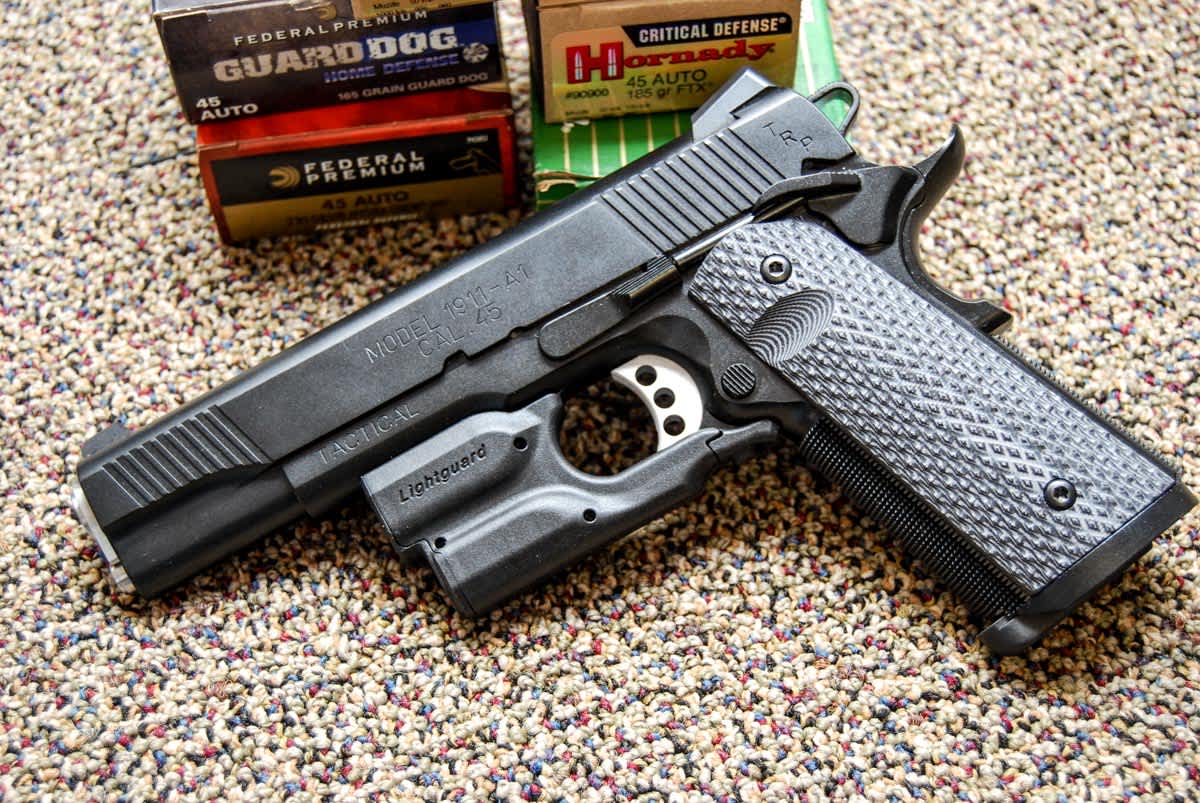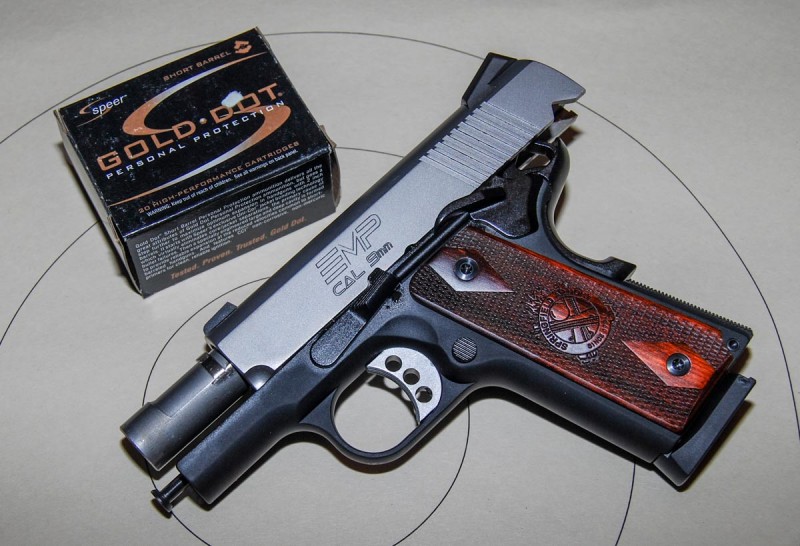What Makes a 1911 a 1911?
Tom McHale 07.29.14

Love it or hate it, the 1911 pistol is kind of a big deal, even if just for its longevity. Just past the turn of the previous century, the Army figured out it wanted an autoloading handgun with similar ballistic capability to the .45 Colt, which had served them well. Since our military folks rode around on horseback at that time, features like easy one-handed operation and grip safeties were important. If you drop your handgun mid-gallop, you don’t want it to go off when it hits the ground.

In response, John Moses Browning, may he rest in peace, came up with the 1911. The Army liked its ease of use and hard-hitting power, which, according to 1911 guru Robert Campbell, is akin to “a velvet covered brick.”
You’ll hear gun folks talk in reverential tones about the pistol named 1911. Yes, it’s a year, but it’s also a pistol design. Not a manufacturer or a specific model, but a design—kind of like how a pickup truck is a design. Lots of car manufacturers make pickups, and you can get them with different-size engines, but they all have some common features, like seats in the front and a cargo bed in the back.
What really makes a 1911 a 1911
The purist definition of a 1911 might be an a pistol that exactly copies John Moses Browning’s famous design produced in the year, you guessed it, 1911. But even that was tweaked by the military a few years later with the A1 model. Since that time, thousands of gunmakers have produced 1911-style pistols with various tweaks to the original design.
At what point do “design enhancements” cause a gun to be something other than a 1911? Are there design features that, if tampered with, cause a 1911 to morph into something else?
Perhaps the best way to define a 1911 is by a collection of characteristics:
Short recoil operation with tilting barrel and swinging link
You’ll notice that 1911 pistol barrels have a moving link on the bottom under the chamber. As the pistol fires, the barrel and slide move backward together for a short distance. At this point, the link rotates the breech end of the barrel downward, unlocking it from the slide. This allows the slide to travel backward and eject the spent cartridge case. The recoil spring sends the slide forward, picking up a fresh cartridge along the way and recapturing the barrel.

Grip safety
On a 1911, the back of the grip has a safety “pad” that is pushed into the frame by the web of your shooting hand. This safety blocks movement of the trigger, preventing the gun from firing.
Single-action trigger
On a classic 1911, the trigger does one thing: release the hammer (hence the term single-action). As a result, the trigger feel is the same for each and every shot and is generally light and easy to pull. On a handgun where the pressure required to move the trigger is usually more than the weight of the gun, an easy trigger helps the shooter keep the gun on-target as pressure is applied.
Trigger geometry
Unlike most other popular handguns that use a trigger that is hinged at the top, a 1911 trigger pushes straight back like a sliding glass door. It’s another feature aimed at preventing your trigger-press motion from moving the gun off-target.
Slide lock safety
The positive safety blocks the hammer and sear, again preventing discharge of the pistol. As the 1911 is a single-action design, it’s supposed to be carried with the hammer cocked. This explains the 1911 terminology “cocked and locked.”

What doesn’t (necessarily) define a 1911
You’ll notice some glaring omissions from the list above. Just as pickup truck design has expanded and morphed over the years, so has 1911 design. Some original characteristics don’t necessarily define a 1911 anymore. Companies have even stretched the bounds of the list above with models that aren’t truly single-action. Exceptions are now the rule.
.45 ACP caliber
While the original design was specific to .45 ACP caliber, that’s no longer true. 1911-pattern pistols are available in a slew of calibers including 9x19mm, .40 S&W, .357 SIG, 10mm, and more.
Barrel bushing
John Browning included a barrel bushing in his design that perfectly fits the barrel to the slide. While most 1911s still use a bushing, some models, especially compact designs, have a barrel shaped to mate with the slide without a bushing.
Internal extractor
A 1911 purist might insist that a real 1911 has the cartridge extractor and spring mounted completely on the inside of the slide, thus invisible from an exterior view. Many modern iterations use an exterior extractor similar to those present on popular polymer guns.
Guide rod, or lack thereof
Most modern pistols have a recoil spring guide rod through the center of the spring. The intent is to keep the spring straight and prevent it from kinking. The Browning 1911 design did not have (or need) one, and a simple recoil spring plug was used to contain the spring in the pistol’s frame. Some manufacturers have added full-length or two-piece guide rods in an effort to increase accuracy and/or reliability. If you want to start a war on an online gun forum, just bring up the topic of whether 1911s need guide rods!

What really matters
Love it or not, the 1911 has been around a long time. The fact that it’s still a popular pistol choice for civilian and military use after 103 years is impressive. While gun makers have modified and tweaked certain features, the basic design remains the same.
At risk of committing gun heresy, I don’t get all wrapped up in the debate over whether a specific gun is a “true” 1911 or not based on how certain features are implemented (or not). I don’t care if a particular model has a full-length guide rod or bushing-less design. I just like 1911s.
Why? For me, my preference boils down to two things, and neither of them has to do with the use of .45 caliber “tank-stopper” ammunition.
- Ergonomics. I really like the 11-degree grip angle. If I raise a 1911 towards a target downrange with my eyes closed, then open them, I’ll be pretty much on-target. A 1911 points naturally for me. I also like the circumference and grip size. It just works.
- Single-action trigger. I like the combination of single-action operation and a non-hinged trigger. When I shoot, it’s easy for me to execute a smooth trigger pull.
The important thing is what these two features do for me, not the particulars of the design and whether or not they are original. These two design features make it easier for me to hit my intended target—nothing more. It’s just that simple.
If you haven’t shot a 1911-pattern pistol, try one out. Don’t all worked up about theoretical design tradeoffs. If you like it, and it’s reliable for you, then go for it, regardless of guide rods, extractors, and bushings.
Tom McHale is the author of the Insanely Practical Guides book series that guides new and experienced shooters alike in a fun, approachable, and practical way. His books are available in print and eBook format on Amazon.

